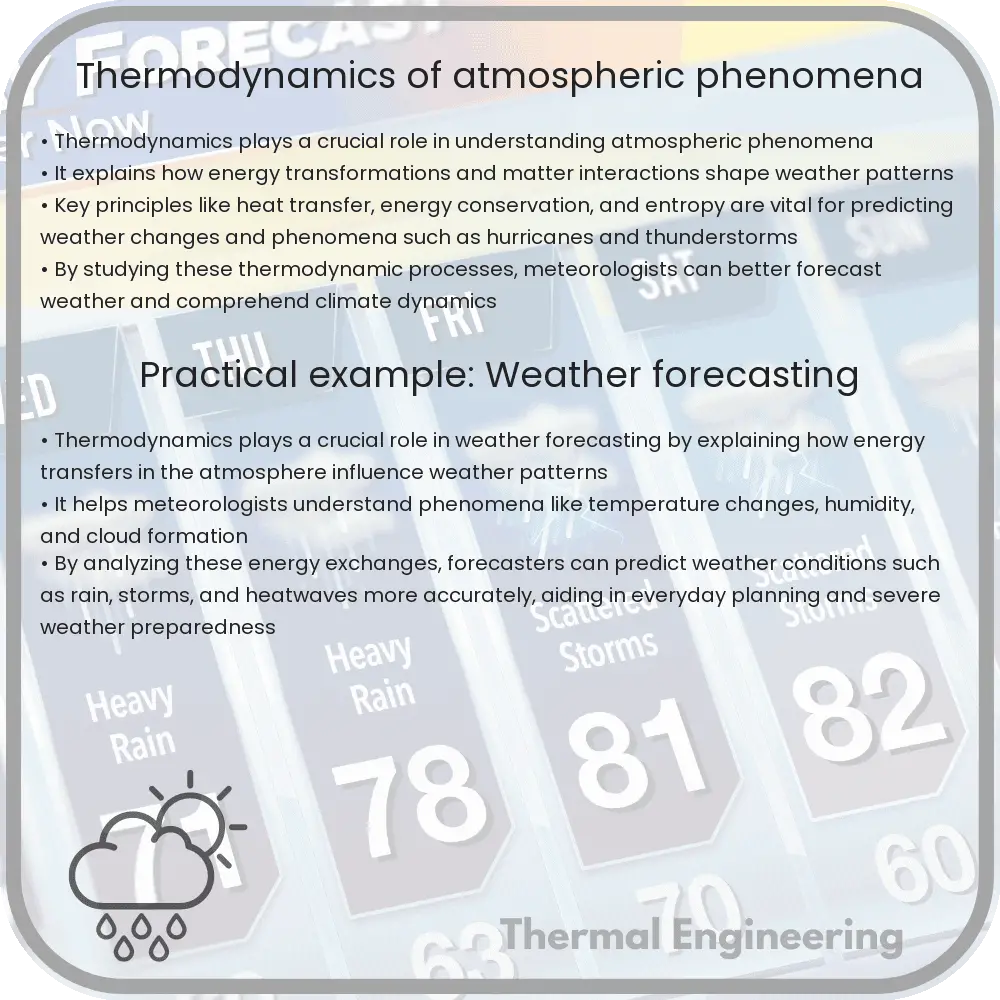Learn how thermodynamics governs atmospheric phenomena, from energy transformations to weather patterns and climate.

Thermodynamics of Atmospheric Phenomena
Thermodynamics plays a crucial role in understanding and predicting atmospheric phenomena. It’s a branch of physics that deals with the relationships between heat and other forms of energy. In the context of the atmosphere, thermodynamics helps us understand how heat transfer affects weather patterns, climate, and atmospheric conditions.
Basic Principles of Atmospheric Thermodynamics
Atmospheric thermodynamics involves several fundamental principles and laws, key among them being the First and Second Laws of Thermodynamics:
- The First Law of Thermodynamics, also known as the Law of Energy Conservation, states that energy cannot be created or destroyed, only transformed from one form to another. In the atmosphere, this principle can be observed in the conversion of solar energy into thermal energy, contributing to phenomena such as wind and precipitation.
- The Second Law of Thermodynamics states that entropy, or disorder, in an isolated system will tend to increase over time. This law explains the spontaneous heat transfer from warmer to cooler parts of the atmosphere and is fundamental in studying weather systems and energy dispersion.
Two critical variables that are often discussed in atmospheric thermodynamics are temperature and pressure. These properties are related by the ideal gas law:
PV = nRT
Where:
- P is the pressure
- V is the volume
- n is the amount of substance
- R is the ideal gas constant
- T is the temperature in Kelvin
Heat Transfer in the Atmosphere
Heat transfer in the atmosphere occurs mainly via three processes: conduction, convection, and radiation:
- Conduction is the transfer of heat through a medium from a region of higher temperature to a region of lower temperature. It is less significant in the atmosphere due to air’s poor conductivity.
- Convection involves moving the heat by the physical movement of air masses. Warm air rises due to its lower density, and cold air descends, creating convection currents that power weather systems such as thunderstorms and hurricanes.
- Radiation refers to the transfer of energy by electromagnetic waves. The Earth absorbs solar radiation, which heats the surface and is re-emitted as infrared radiation. This process is crucial in the Earth’s energy balance and affects atmospheric temperatures.
Application of Thermodynamics to Weather Patterns and Climate
Thermodynamics aids meteorologists in predicting and understanding weather patterns through the analysis of atmospheric pressure, temperature, humidity, and wind. For example, the Clausius-Clapeyron equation is fundamental for predicting how much moisture the air can hold before it condenses and forms precipitation:
dp/dT = L*p / Rv*T2
Here, dp/dT is the rate of change of pressure with temperature, L is the latent heat of vaporization, p is the saturation vapor pressure, Rv is the gas constant for water vapor, and T is the temperature in Kelvin.
Understanding these principles helps in constructing accurate weather models and forecasting tools that are essential for agriculture, aviation, and day-to-day weather predictions.
Concluding Thoughts
Thermodynamics forms the foundation of meteorological science, enabling the detailed study of atmospheric phenomena. By understanding how energy transforms and moves through the atmosphere, scientists can better predict weather patterns and their impacts on the environment and human activities. This knowledge is essential not only for scientific pursuits but also for practical applications in various sectors affected by meteorological conditions.